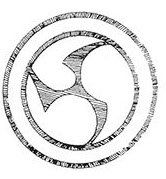Address: York Ave • 78th St • NYC | Email: pdemetri1701@gmail.com
TRISKELION
The Triskelion Symbol
The three-pointed swirl is a symbol that can be found in many cultures. A tripartite division of a circle by three curved arms, it suggests both circular motion and a division that can represent body, soul and spirit or past, present and future. It is considered, as a talisman, to help one adjust to the course of life. As an amulet, it is said to protect against imbalance.
A Paradoxical Symbol
It is hard to capture the essence of psychotherapy
in descriptive language so I take inspiration from this enigmatic, cross-cultural symbol. Embodied within the triskelion
lies the paradox of looking for stillness within motion or seeking permanence within change. Awash in a kaleidoscopic world we all, in one way or another, are looking to find some semblance of personal stability in order to provide a focal point or calm center from which to take our bearings and chart a constructive course forward.
When, at some point in our lives, the strong headwinds we encounter threaten to overwhelm the anchors we have managed to set in place, psychotherapy can often be of help. Recent research on brain function has revealed that we are hardwired to find support within the emotional connection which can be found with the right therapist.
When I look at the triskelion I see the challenge of our lives - having to navigate through division which is forever in motion. I can also see the opportunity to move toward the center where I envision a still axis which can provide shelter from the storm as well as a vantage point from which to survey the divisions in motion. That is where we aim to go into therapy. The emotional experience of the disparate parts of the self is key, while discovery and integration can take many forms.
— The Book of Balance and Harmony
“Change and movement have their times; safety and danger are in oneself. Calamity and fortune, gain and loss, all start from oneself. Therefore those who master change are those who address themselves to the time. For those who address themselves to the time, even danger is safe; for those who master change, even disturbance is orderly. ”
Phone:
(845) 702-2162
| Email:
pdemetri1701@gmail.com
| Address: York Ave • 78th St • NYC
Call to schedule an appointment
Monday - Friday, 12:00 PM - 9:00 PM
Content, including images, displayed on this website is protected by copyright laws. Downloading, republication, retransmission or reproduction of content on this website is strictly prohibited. Terms of Use
| Privacy Policy






